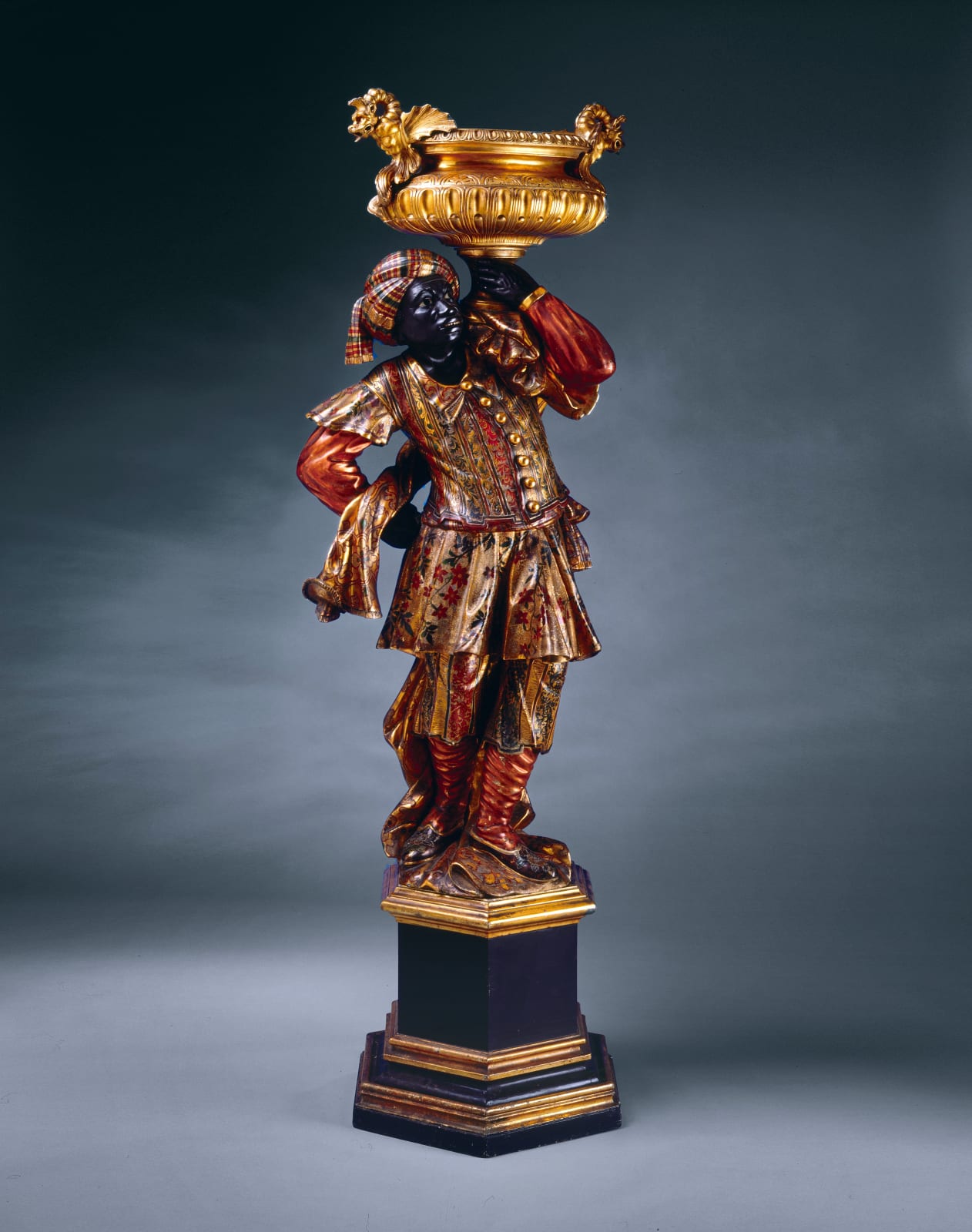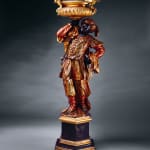Unknown
A marvellous pair of North Italian Blackamoors, date circa 1860. The carved wood figures of painted polychrome and gilt depicting exotic courtiers, richly dresses with tartan turbans, each holding above their heads a gilded gadrooned jardinière with dragon handles. Both standing upon black and gilt painted hexagonal plinths
North Italy, date circa 1860
Height 240 cm each
Through out history Western artists and craftsmen have been inspired by images from the East and North Africa. Ancient Greek, Roman and Egyptian art featured negro figures while African heads appeared as a fairly common decoration for Renaissance cameos. During the Seventeenth Century, Europeans particularly prized the stature and fighting ability of the North African warriors and thus many were enlisted by princes or wealthy Italian families as part of their private army; they were also appointed as personal body guards or bearers and could be seen at Court in full exotic dress.
By the mid-late Seventeenth Century Venetian sculptors began carving wooden likenesses of these handsome figures in the form of blackamoors. Either nude or in native costume they appeared as free-standing, often life size sculptures, serving little practical use other than as a stand for a candelabra or jardinière; occassionally they appeared crouching beneath a foot stool or as supports for a display cabinet. The major expones': of the negro figure was the sculptor, Andrea Brustolon (1662-1732), who from c.1684 worked for the major Venetian families. Brustolon carved some magnificent Baroque sculptural furniture including a vase-Bland which incorporates negroes, classical river gods, Charon, Cerberus and the Hydra (Palazzo Rezzonico, Venice). He also carved guéridons the form of athletic negro slaves supporting trays.
Craftsmen from Florence, Milan and other north Italian cities famed for the superb quality of their wood carving, soon followed the Venetian example Blackamoors continued to be made in Italy throughout the Eighteenth Century and are still produced there today. During the mid-late Nineteenth Century there was a major revival of such works. This was due to a number of factors, no less than the Romantic fascination for the Orient, manifest in paintings by Delacroix and other European artists who travelled to North Africa. At the same time, and throughout the nineteenth Century many European craftsmen were reviving past historical styles. Including Baroque works of art, such as blacktamoors. As highly fashionable pieces, they were either specifically commissioned or purchased by travellers to Italy during the Grand-Tour.
Many nineteenth Century examples were based on Seventeenth Century prototypes. Figures usually stand upon a plinth, holding or supporting a tray, torchère, candelabrum or jardinière, such as the pair in the present collection. The magnificently carved near life-size courtiers stand upon hexagonal bases and have oval jardinières with dragon handles (and original liners), resting upon their shoulders. Each are worked in high gilt and painted polychrome and are dressed In rich and exotic costumes.. For the past 25 years they were owned by Dr Gerald Moore of Heatfield Park, Sussex, England, whose Seventeenth Century hone and impressive collection were sold in May 1993. Before this the pair were in another private collection in the west of England. Great care must be taken when handling such pieces for they are easily damaged due to the nature of their soft wood and high finish. However good Nineteenth Century Blackamoors in fine condition are particularly sought after; the value o:' this exemplary pair is considerably enhanced as each figure is in a different but correspondingly balanced pose.
The Italians of seventeenth century particularly admired the physique and fighting ability of the North African Warriors; many could be found as bearers at Court or as bodyguards to an Italian Prince. By the end of the century Venetian and Milanese craftsmen began carving likenesses of these handsome men. Known as Blackamoors, they appeared as supports for cabinets and footstools, or - as we see here - as free standing figures supporting a jardiniere; others nay have held a candelabra or vase. Though blackamoors continued to be made during the 1700's, it was not until the nineteenth century that their popularity was once acre revived.
Made in North Italy, circa 1860, this pair are, without doubt, the finest nineteenth century Blackamoors to appear on the Market within the last 20 years. Not only does their fine carving and high gilt and painted polychrome finish equal many earlier pieces, but they have the advantage of being in near perfect condition. Condition is vital, since over the years, the soft wood and high finish can easily be damaged. It is also rare to find a pair of figures in different but corresponding poses. The life-size courtiers in rich exotic costumes stand upon hexagonal plinths. Above then they hold gilded Jardinieres containing their original liners.
Such pieces were as popular during the last century as they are now. Many were bought directly from Italy by English collectors.



